Act 1 [a star is born]
1925 was the perfect moment to form the Brisbane Repertory Theatre Society, BRTS. Brisbane was awash with theatres with over 100 opening nights happening across the city that year, and repertory theatre was already flourishing in Sydney, Melbourne and Adelaide.
Barbara Sisley, a professional actress who had been encouraged into theatre by her father, a civil servant who taught elocution on the side, was stranded in Brisbane after the company she had been touring with folded suddenly in the early 1910s. An independent, resourceful and charismatic young woman, a British immigrant, she quickly established herself as a teacher of speech and drama and was instrumental in establishing a number of dramatic societies around town including her very own Barbara Sisley Players. Following a 2 year sabbatical back in England to study with the famed voice and acting coach Elsie Fogarty at her Central School of Speech and Drama, Sisley returned to Brisbane in late 1923 deeply inspired by the vibrant repertory theatre scene in London. And she was brimming with ideas.
Somewhere along the way, she joined forces with the younger but equally dynamic Professor Jeremiah Joseph (J.J.) Stable to establish the Brisbane Repertory Theatre Society. J.J. was worldly, having been raised in Switzerland following his father’s early death in South Australia and educated all over Europe, finishing with a Master of Arts from Oxford University. Slipping effortlessly into academia, he married a Queensland girl, and soon accepted a position as Lecturer in Modern Languages at the newly established Queensland University in 1912. In his first year in Brisbane, he set the university’s courses in English, French and German and co-founded the University Dramatic Society, acting in a number of their productions. When World War I was declared Stable was requisitioned and appointed to the role of Queensland’s Chief Censor, a somewhat controversial position that brought him into direct conflict with Queensland’s anti-conscription Premier T.J. Ryan. From all reports, he performed his duties with diplomacy and courtesy, emerging from the war years with his reputation intact. In the early 1920s he encouraged the university to introduce Australian literature to its courses, and it became the first university in Australia to do this.
Left: Barbara Sisley, 1923. Image courtesy Joan Massey Cook and Christine Comans.
Right: Professor Jeremiah Joseph (J.J.) Stable, ca.1935. Image courtesy Robert Stable and Christine Comans.
It is unclear exactly where and when Sisley and Stable met, but they were of a similar mind – Brisbane needed a repertory theatre group as a logical next step in its cultural evolution. Repertory theatre is where a group, usually amateur, maintain a roster of plays ready to perform, adding and preparing new plays along the way. Starting in England as a backlash against the increasing number of American plays being produced in commercial theatres, it became hugely popular as a way of engaging with the new work coming from Ireland, the United Kingdom and Europe more broadly. It was already thriving in Australia, inspired by similar ideals of producing plays of literary and artistic merit. The goal was not monetary success. It was more about education and creating a community around theatre in which people could participate as artist or audience. At its heart, BRTS always maintained “the play is the thing”.
The Brisbane Repertory Theatre Society’s first production – The Dover Road, a contemporary comedy by English author A.A. Milne – premiered on Friday 31 July 1925. While the early plays were relatively conservative the program grew more daring as the company gained confidence with the inclusion of Australian and even Queensland plays, and tackling issues like divorce, mental illness and inter-racial marriage. BRTS relied on both its membership and programming success for financial stability and these certainly fluctuated, depending on the economic conditions. A big drain on the company was the cost of hiring theatres, and BRTS hoped to have a home of its own one day.
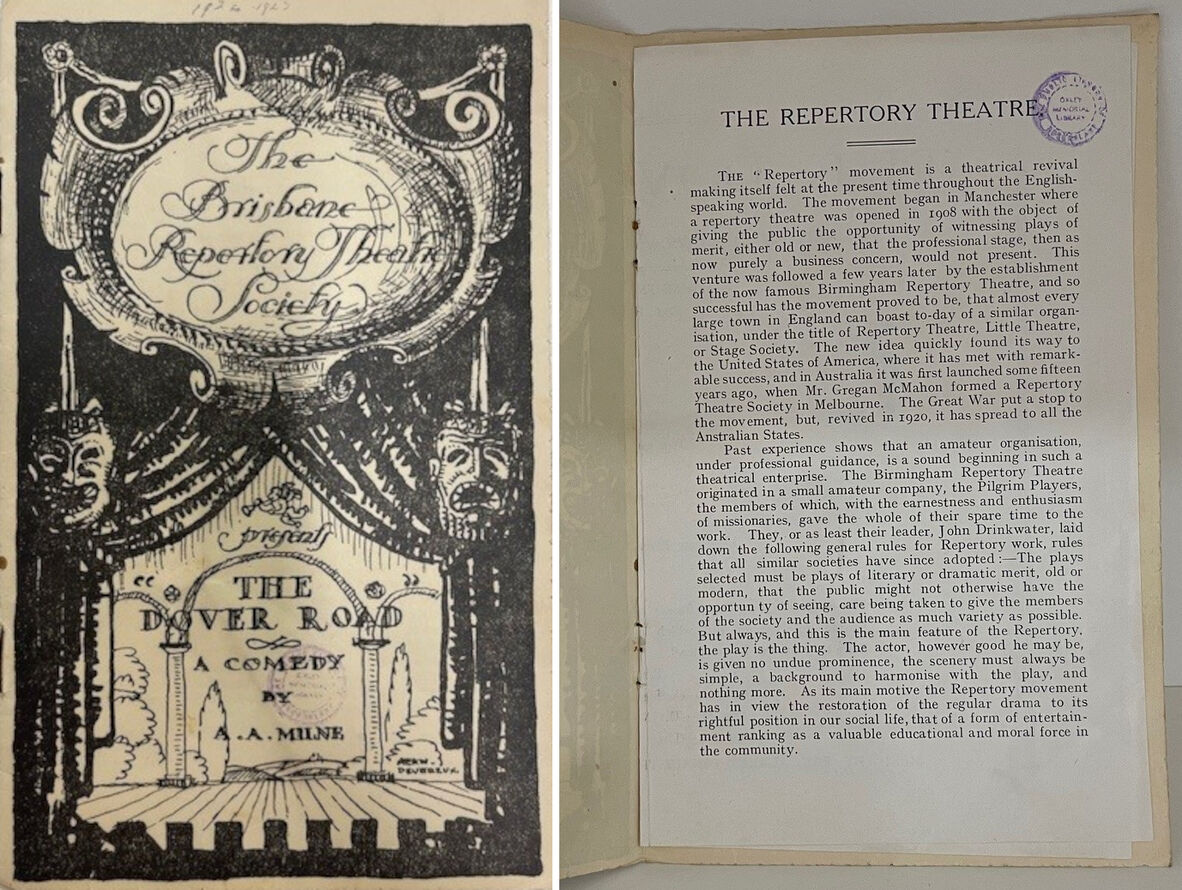
Program for "The Dover Road" by A.A. Milne [front cover and inside page], 1925.
JEPH: Theatre programs (Brisbane Repertory Theatre Society / La Boite Theatre). John Oxley Library, State Library of Queensland.
The Depression years of the early 1930s were relatively hard for the fledgling company. A lease arrangement with the Princess Theatre in Woolloongabba in 1934 was a welcome relief and although membership was high, BRTS ran at a loss in 1936. The company was also faced with new competition. Rhoda Felgate who had been a founding member of BRTS struck out on her own to form Twelfth Night Theatre. And a husband-and-wife team, Jean Trundle and Vic Hardgreaves, established Brisbane Amateur Theatres, later known as Brisbane Arts Theatre. Both of these new companies were formed in 1936.
BRTS fought back, something which would become a trademark for this particular company. The Committee appointed Barbara Sisley as the sole producer/director for the 1937 in an effort to develop a ‘house style’, paying her a set fee for the year. Despite the successful season and strong fundraising activity, the financial strains of leasing the Princess Theatre were beginning to be felt. And the outbreak of World War II didn’t help matters.
With quite a large debt hanging over the company at the end of 1939, J.J. Stable was once again appointed Queensland’s Chief Censor and the company lost artists and members alike to military service. Desperate to keep Stable’s association with the company, the Committee elected him President-on-leave, despite him tendering his resignation more than once. By 1942 memberships had dwindled to around 70, and the company’s lease with the Princess was ended when South Brisbane was declared out of bounds to civilians. BRTS managed to produce 6 or 7 plays each year during the war,and as ever, took advantage of a golden opportunity with a new lease arrangement secured at Albert Hall, a venue that became the company’s ‘home’ for the next 25 years. Finally the easing of blackout requirements and a new membership drive resulting in a significant upturn in revenue.
The company, however, was in for the biggest shock of its journey so far. J.J. Stable had already signalled his intention to resign, permanently this time, ending his tenure as President halfway through 1945. Only a few months later, on 17 November, Barbara Sisley was struck by a taxi on her way out on a Saturday night only metres from her home on Adelaide Street. She died a day later in hospital. Her death was a shock for the entire arts community and a profound blow for Brisbane Repertory Theatre Society. The Society decided to proceed with its upcoming production, Sons of the Morning, which opened on 21 November. The show must go on. Sisley was listed as Producer in the programme.
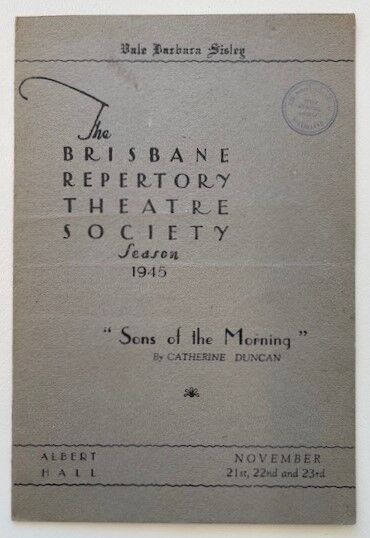
Program for "Sons of the Morning" by Catherine Duncan, November 1945. This play was staged days after the sudden death of its producer and company co-founder Barbara Sisley.
JEPH: Theatre programs (Brisbane Repertory Theatre Society / La Boite Theatre)
Act 2 [the next 25 years]
For the next 10 years, following the loss of Sisley and Stable, the company cycled through 4 different Presidents. Ultimately their focus was on rebuilding the organisation while remaining loyal to the legacy left by its founders. Together, they ensured the show did go on and each wrought their own small changes. In 1946 ‘Society’ was dropped from their name. In 1948, Alex Foster led a membership drive targeting Brisbane’s elite which saw numbers rise to almost 800. The Constitution was amended in 1951 limiting the term of Presidents to 3 years, embedding continuous renewal. And in 1956, President Gwen MacMinn led a ‘premises appeal’ raising £300 for the purpose of realising the company’s long held dream of finding its own permanent home.
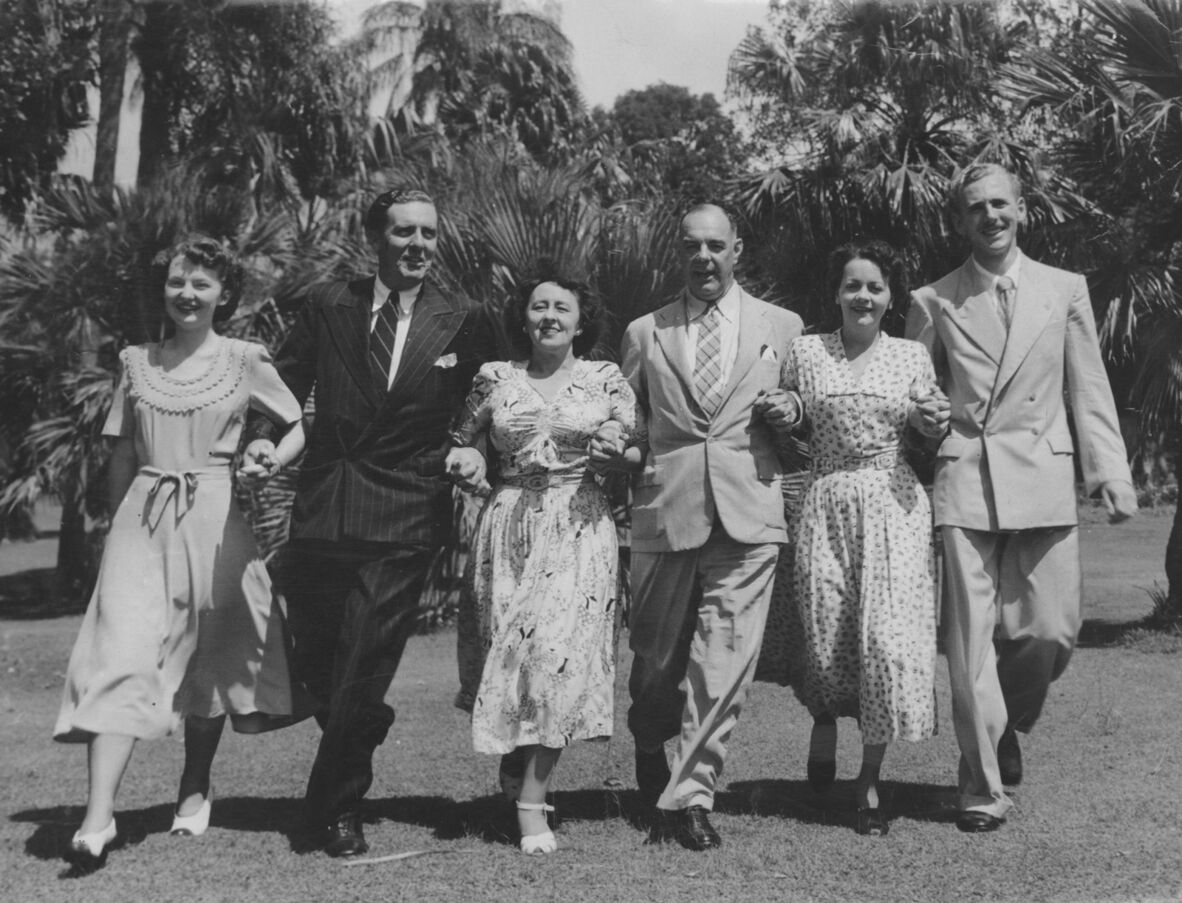
Babette Stephens [3rd from left] and Gwen Wheeler with fellow members of the Brisbane Repertory Theatre, ca.1952. Photograph by E.H. Turner.
Image no. 2001_058_159. John Oxley Library, State Library of Queensland.
Babette Stephens took over as President in 1957. She had a long history with BRT and was one of its leading actors. The organisation prospered under her clever and dynamic leadership, with membership growing to 920 and the number of performances for each play doubling from 4 to 8 nights. Arguably her biggest contribution was when she oversaw the purchase of 3 adjoining houses on Hale and Sexton Streets in inner-city Petrie Terrace. At the end of her 3 year term she was offered the role of Theatre Director with an unprecedented annual fee of £250 attached. She worked closely with another BRT ‘star’ Gloria Birdwood-Smith to develop a new house style, centred mostly on contemporary international productions. Together Babette and Gloria became the grands-dames of Brisbane theatre, nurturing the next generation of Queensland talent. Babette was so well known she went on to became a much loved feature of the new medium of television, appearing on game shows and serial dramas until the 1980s.
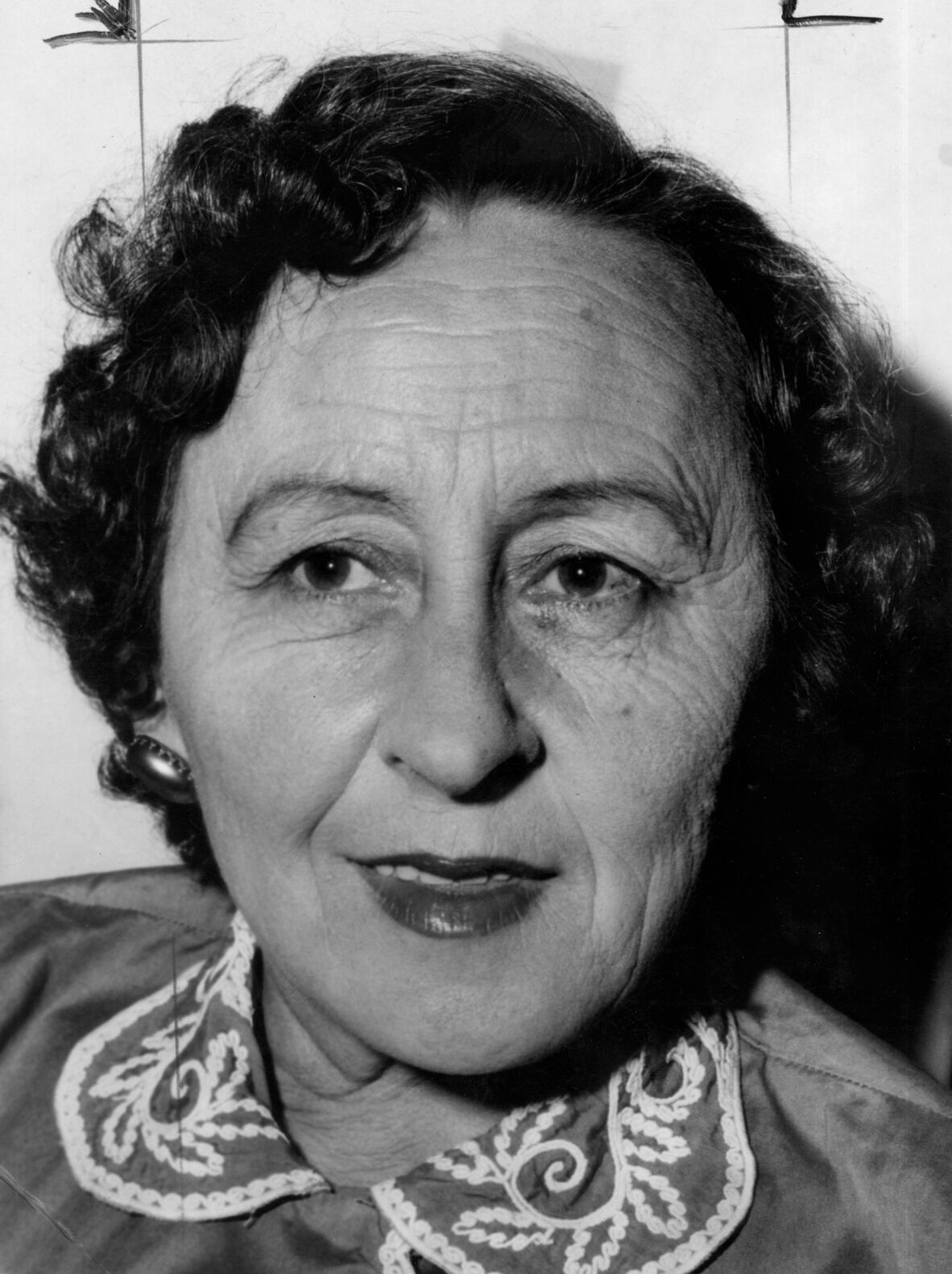
Babette Stephens, 1957. Photographer unknown. Negative no. 199071. John Oxley Library, State Library of Queensland.
Meanwhile, during the 1960s, the Bruce and Jennifer Blocksidge had become heavily involved in the company. When BRT was forced to find a new location upon learning that their ‘home’ of 25 years, Albert Hall, was to be demomlished, Bruce Blocksidge jumped at the idea of staging workshop plays in one of the company’s cottages at Petrie Terrace. He and Jennifer had recently visited the Hayes Gordon Ensemble Theatre in Sydney – a theatre-in-the-round operating in a converted boat shed – and were convinced the concept would translate well. Bruce Blocksidge even suggested a name: La Boîte, or ‘the box’ in French. It was the name of a small coffee shop frequented by the theatre set in London, around the corner from where he lived while he was studying. Stephens was far from convinced but was eventually persuaded that the cost efficiencies were worth it.
The new 70 seat La Boîte, at 57 Hale Street, opened on 23 June 1967 with a production of the English realist drama Look Back in Anger. Audiences loved the intimacy of theatre-in-the-round. This new direction for the company led to significant renewal when Babette Stephens stepped aside in 1969 and Jennifer Blocksidge took over as honorary Theatre Director.
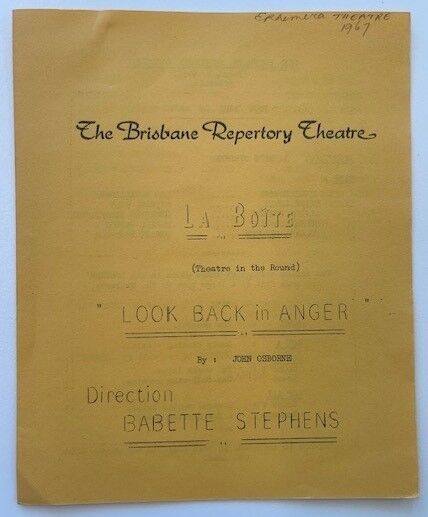
Program for "Look Back in Anger" by John Osborne [at the new La Boite theatre], 1967. Brisbane Repertory Theatre. JEPH: Theatre programs (Brisbane Repertory Theatre Society / La Boite Theatre). John Oxley Library, State Library of Queensland.
Act 3: [a new dawn]
Under Jennifer Blocksidge’s influence, BRT’s repertoire grew more challenging and more Australian. She maintained the hectic pace, ensuring La Boîte played every week of the year including Easter and Christmas. Its high quality productions meant it was able to attract talented people to participate in all aspects of the theatre, which in turn attracted audiences. The company soon outgrew its 70 seat cottage theatre and Blocksidge envisioned a new larger theatre. The dream became a reality when the Queensland government agreed to match the company’s funds dollar for dollar in 1971, and Blocksidge immediately engaged architect Blair Wilson to design and deliver a brand new, purpose-built theatre-in-the-round for Brisbane Repertory Theatre.
Wilson had recently returned from Finland where he was impressed by the simplicity of the architecture where materials ‘spoke for themselves’ in a minimalist yet warm way. Demolition of the old La Boîte was suddenly brought forward to meet Council requirements, forcing upcoming productions into a ‘tent theatre’ – as always, the show must go on. Despite these minor upsets, Wilson delivered an incredible building on a very modest budget, the longed-for permanent home the company had always wanted. The new 200 seat theatre was successful on many levels fostering a deeply intimate relationship between the audience and the actors. Put simply, it was an astonishing achievement for an amateur theatre company and while it was indicative of Jennifer Blocksidge’s drive and vision, it built on the work done by other equally passionate leaders before her.
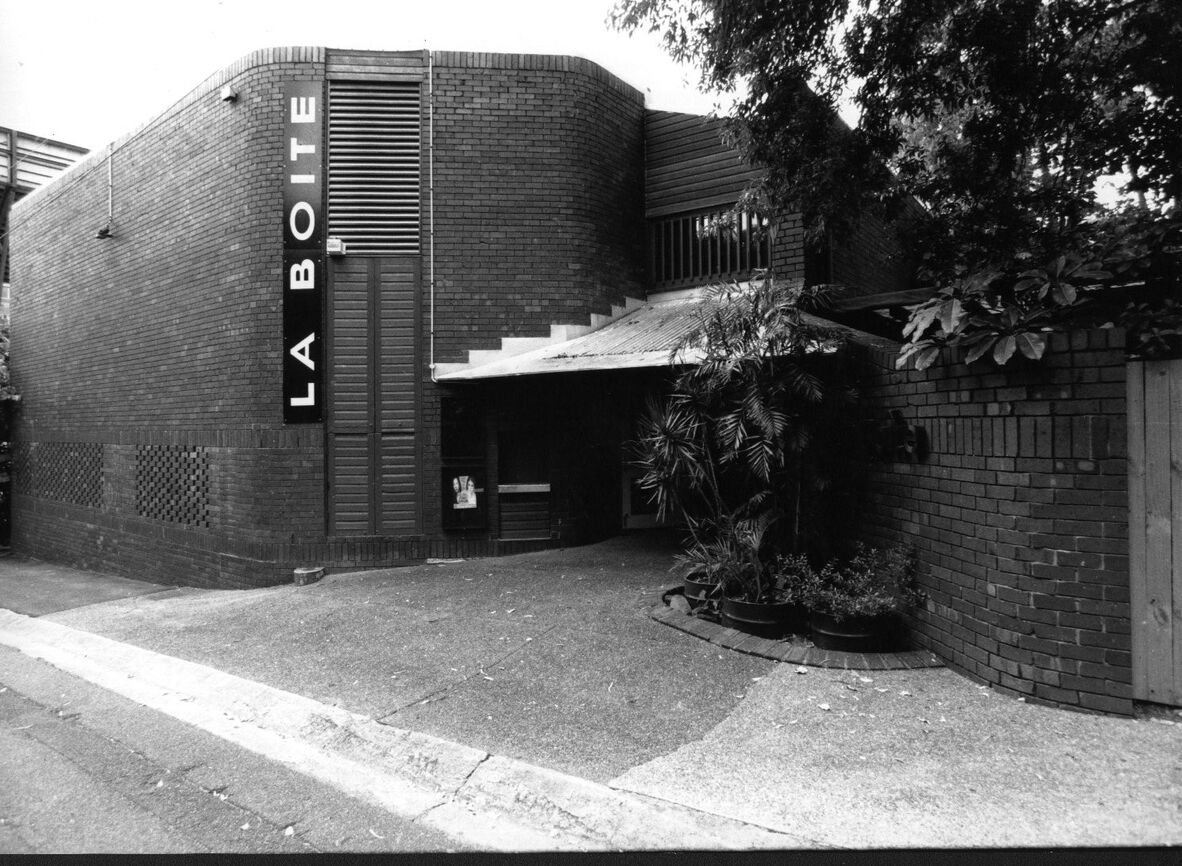
La Boite Theatre building at 57 Hale Street, Petrie Terrace, ca.1972. Image courtesy La Boite Theatre Archive and Christine Comans.
The gala premier performance in the brand new building was on 10 June 1972, a production of the Australian play A Refined Look at Existence. Proving her credentials as a visionary leader, Blocksidge set about introducing the first ‘theatre-in-education’ team in Queensland as well as the Early Childhood Drama Project. However, despite all the successes, tension was developing between the company’s amateur status, where everyone worked for free, and the growing desire to professionalise, and pay people for their work. Blocksidge resigned her position as honorary Theatre Director in 1975 so the company could appoint its first salaried Artistic Director.
Rick Billinghurst was one of Australia’s most celebrated and talented theatre directors. A NIDA graduate who had worked all over the country, he set about introducing a new subscription model and overhauling BRT’s marketing. From this point on, the company promoted itself as La Boîte. His first production, a controversial new Australian play The Floating World was a smash hit. By the end of his tenure in 1979, over 40,000 people had attended 550 performances and incredibly, half of these were children mostly under the age of 8. Following his departure the company adopted four principles to guide their strategic approach:
- That the theatre would focus its future and program on the encouragement of new writing – particularly by local writers
- That the [new] Artistic Director be forward thinking with a vital interest in new forms of theatre, new ideas and the encouragement and development of local writing
- That the Council [the company’s governing body] confirms that it will plan to make Brisbane Repertory’s La Boîte Theatre the recognised alternative professional company, should the opportunity arise
- That the Council work towards professionalism as the only way to ensure proper recognition of the theatre’s artistic goal.
Act 4 [the tumultuous 1980s]
La Boîte’s success continued into the early 1980s. Artistic Director Malcolm Blaylock (1980-1982) programmed innovative and risky works, with his first season all-Australian, a first for the company. By the time of Andrew Ross’ appointment as Artistic Director in 1982, tensions and misunderstandings about the pro-am status of La Boîte were almost boiling over. The amateur culture was deeply entrenched at BRT and there was strong pushback from the membership at Ross’ moves to introduce fully professional productions, despite the fact that Ross had been given this remit by the President at the time of his appointment.
Like every arts organisation, La Boîte was heavily reliant on government funding and in 1983, both the state and federal governments cut funding to the company. Ross was forced to leave and La Boîte struggled on with new ‘resident directors’ Mike Bridges and Mary Hickson managing to keep the company afloat with a skeleton staff. La Boîte’s survival was miraculous and was owed, in large part, to the fact they had a permanent home of their own and a small property portfolio to lean on. Funding was restored in 1985 and Bridges and Hickson stood down the following year.
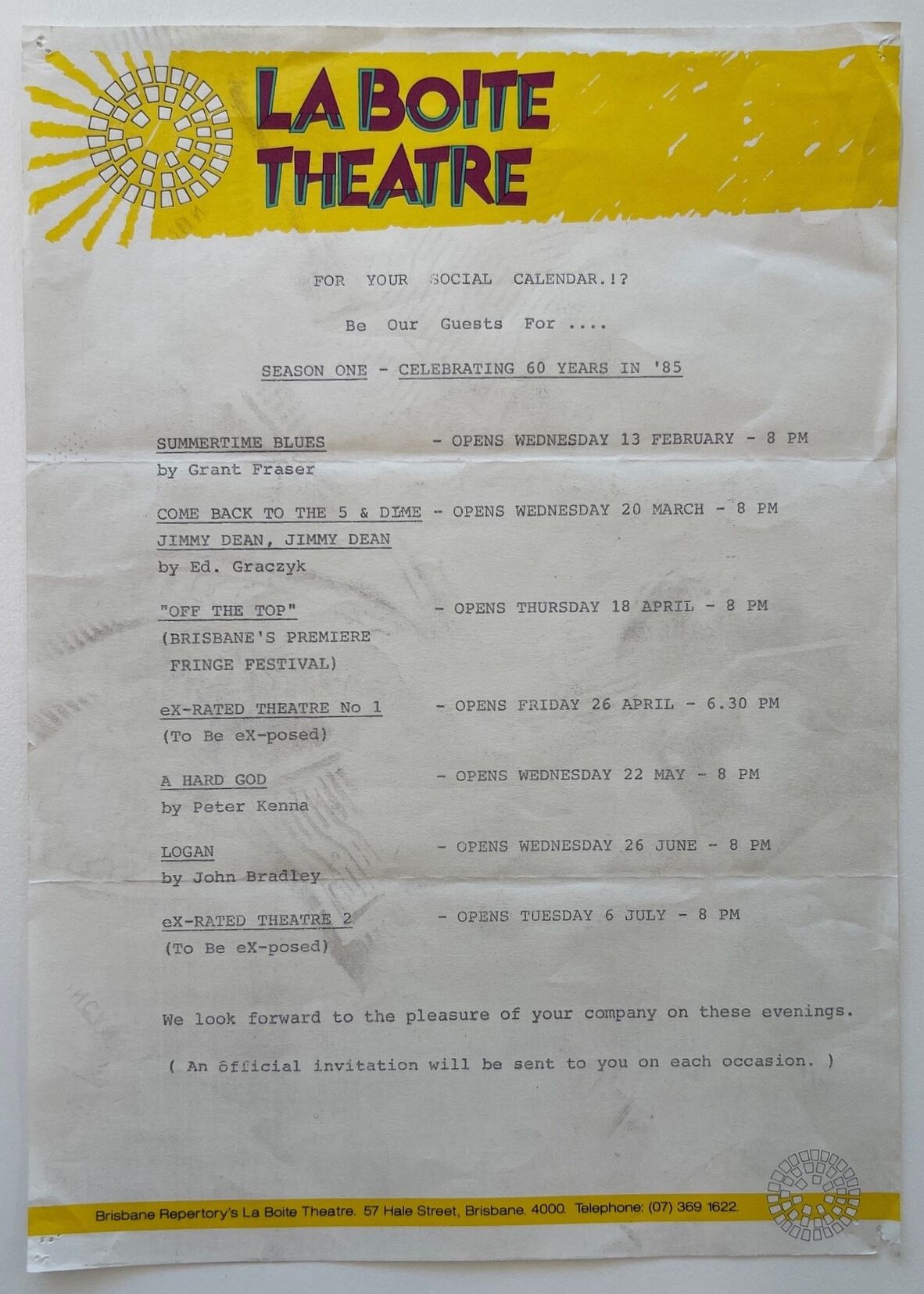
Flyer for "Season One - Celebrating 60 years in '85", 1985. La Boite Theatre. JEPH: Theatre programs (Brisbane Repertory Theatre Society / La Boite Theatre). John Oxley Library, State Library of Queensland.
Jim Vilé was appointed as Managing Artistic Director – a CEO and Artistic Director rolled into one position – in 1986. He was a believer in ‘open door’ programming where there was something on every day and night of the month. The frantic pace intensified during World Expo 88 and La Boîte ran its largest ever program by far during that watershed year in Brisbane. Despite all the success, the tensions between amateur and professional status of the company persisted. Vilé was uncomfortable with not paying professionals, who were only too happy to work with such an esteemed company as La Boîte.
The issue finally boiled over in 1990, the first year of Patrick Mitchell’s tenure as Managing Artistic Director, when three of the five Matilda Awards went to professional actors for roles in unpaid La Boîte productions. Mitchell dramatically resigned at the launch of the 1991 season. He was succeeded by David Bell later that year who only accepted the position on the understanding that the company would become fully professional under his leadership. The Council agreed.
Act 5 [professionalisation]
Bell, whose background was in cross-arts media, ran his first season on a profit-share basis as a transition towards professionalisation. However his innovative approach to blending traditional theatre with circus, opera and contemporary dance, was not particularly popular although it garnered critical acclaim. When Australia went into the recession it ‘had to have’, the company was once again in financial distress.
Incredibly the Queensland Arts Minister at the time, Dean Wells, announced a rescue package for the theatre – a large sum up front, followed by a low-interest loan. There was a catch however. The company would have to match the amount dollar for dollar and appoint a new Artistic Director and a new General Manager, each capable of maintaining a sustainable professional company. To meet the first condition the company made the tough and unpopular decision to sell off one of their properties, a house at 52 Sheriff Street. This small portfolio of properties were La Boîte’s saving grace. Undoubtedly the government would not have come to their rescue without the fact they owned their own theatre and had the back-up of collateral property.
Into this tricky situation came Sue Rider, appointed as Artistic Director in 1993. Along with new General Manager Deborah Murphy, they made a formidable team. Now there was no turning back. La Boite would either live or die as a fully professional company. As a first order of business, the company legally changed its name to La Boite Theatre.
Sue Rider, Artistic Director of La Boite Theatre (1993-2000), date unknown. Image courtesy La Boite Theatre Archive and Christine Comans.
Under Rider's leadership La Boite entered a period of incredible growth, focusing on the performance of new Australian plays and an unwavering commitment to Queensland artists, including Aboriginal and Torres Strait Islander, at a level previously unseen in this state. The quality of her directorship saw the emergence of outstanding professionals across all theatre disciplines. Her clarity of purpose helped differentiate La Boite from Queensland Theatre Company – it was edgier and riskier, a place for cutting edge work. She wrote, on the eve of her departure, about why she had pursued the policies she did:
…Queensland lacked a company with any kind of Australian focus at the time and La Boite was suffering something of an identity crisis and was in need of a vision. …relating to the national scene, it seemed sensible to position the Company as an originator and producer of Australian writing, a Queensland counterpart to Playbox [now the Malthouse Theatre] in Melbourne and Griffin in Sydney.
Sue Rider was succeeded by Sean Mee who had begun his career in La Boite’s Early Childhood Drama Project in the 1980s. The company’s most pressing issue at this point was a lack of space and a rapidly changing inner city landscape.
Act 6 [a big move]
When Sean Mee began in 2000, Lang Park was about to undergo a major redevelopment and construction of the Inner City Bypass was commencing soon. The company's Council realised that these irrevocable changes would render their Petrie Terrace home unserviceable with little prospect for development or expansion. La Boite had well and truly outgrown the 200 seat facility and believed they faced an existential threat if they did not relocate. Luckily, this was also recognised and understood by the company’s stakeholders.
The issue resolved itself when QUT (Queensland University of Technology) agreed to include a theatre in its plans for a Creative Industries Precinct at Kelvin Grove and grant the company an exclusive lease arrangement. La Boite’s final show in its iconic Hale Street building was the aptly titled The Removalists by David Williamson, who attended the production’s opening night. The show was a sell out and a triumphant close to this chapter in the theatre's history. It was followed, almost on the eve of their departure from the site, by a two night showing of The Final Bow, a theatrical farewell to all the memories associated with Hale Street, both the cottage and the brick building.
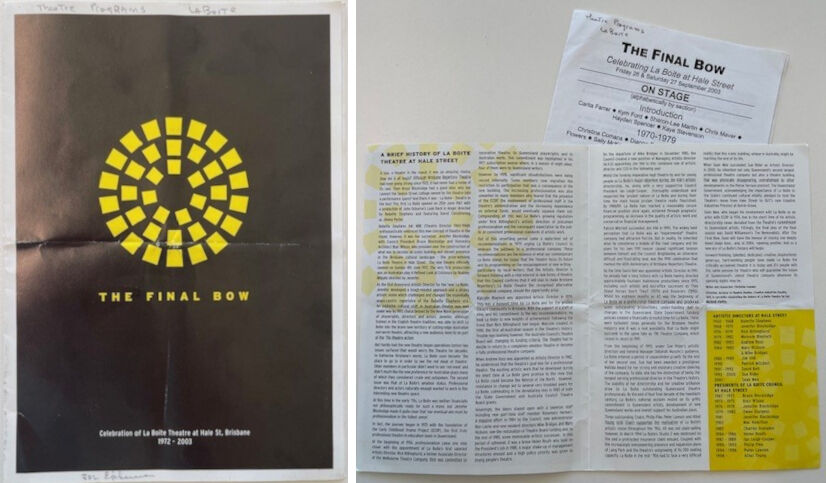
Program for "The Final Bow" [front cover and open], the final performance held at the La Boite Theatre building at 57 Hale Street, Petrie Terrace, 2003. JEPH: Theatre programs (Brisbane Repertory Theatre Society / La Boite Theatre). John Oxley Library, State Library of Queensland
It was definitely time to go. According to Rosemary Walker, La Boite’s publicity manager and longest serving employee:
At Hale Street, our offices flooded many times, there were possums and rats in the roof of the theatre, and patrons getting peed on by possums in the courtyard…
By the end of 2003 La Boite Theatre Company, as it was by now legally known, moved into the Roundhouse Theatre at Kelvin Grove. Moving into this brand new 400 seat theatre-in-the-round, with an exclusive 25 year lease, was a big move. But this company had never shied away from making bold choices. The Roundhouse, although flexible in its configuration, remains Australia’s only purpose built theatre-in-the-round.
Following its physical relocation, Sean Mee set about creatively re-locating La Boite in its new setting. Throughout his tenure (2001-2009) he programmed Australian works only which fell into one of three categories:
- Commissioned new work
- Works of contemporary urgency
- Australian ‘icons’.
In the company’s first season at the Roundhouse, Mee presented 5 new plays by resident Queensland writers, 4 of which La Boite had commissioned. The very first play was Zigzag Street, based on the much-loved book by Nick Earls, and it was a hit. Through this period box office takings soared and subscriptions grew, proving that Mee had attracted new audiences and people loved seeing their own stories on stage.
Act 7 [the last 20 years]
Despite these years of success, economic headwinds were once again on the horizon. The Global Financial Crisis of 2008 saw a significant downturn in the Australian economy. Already running at a loss, La Boite again faced a huge shock when the Australia Council withdrew their 2009-2011 triennial funding. In typical La Boite fashion, they decided this was an opportunity to renew.
Mee stepped down at the end of 2008. He had successfully positioned La Boite as a national leader in the generation of new Australian theatre. In his place, renowned theatre director David Berthold was appointed as new Artistic Director and CEO. Although La Boite had lost its funding from the federal government it retained its state funding, but it was still a time of crisis for the company. Berthold set about broadening La Boite’s scope, including international works in the program while retaining its strong commitment to Queensland and Australian works.
When the company won back its federal funding in 2013, now recognised as a Key Organisation, La Boite was in a period of stability and growth. When Berthold left in 2014 to take over as Artistic Director of the Brisbane Festival he noted that almost 50% of audiences were under 30, “and the rest utterly young at heart and pretty much up for anything”. This statement underscores the enduring appeal of La Boite and its strong connection with its community.
Berthold was succeeded by Chris Kohn who had previously been with the Queensland Theatre Company. Sadly, he was forced to resign soon after his appointment due to family circumstances and was succeeded in turn by actor, director and arts leader Todd MacDonald in 2015. Under MacDonald’s leadership the company sought to bring more cultural diversity and First Nations voices to the stage while continuing to support local work by commissioning Queensland plays. This resulted in big successes such as Prize Fighter, written by artist-in-residence Future D. Fidel, and Single Asian Female, written by Michelle Law.
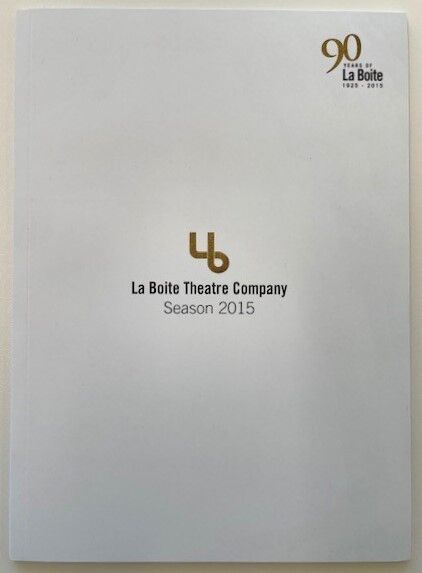
Season program for La Boite Theatre, 2015. JEPH: Theatre programs (Brisbane Repertory Theatre Society / La Boite Theatre). John Oxley Library, State Library of Queensland.
MacDonald stepped down in 2021, as the COVID-19 pandemic shuttered theatres around the world. La Boite used this time wisely, undertaking a year long search for the exact right person to lead the company towards and beyond its next major milestone – it’s 100th anniversary in 2025. Courtney Stewart is the first woman of colour to lead a major non-Indigenous theatre company, and came to the role of Artistic Director with a goal to focus on new Australian work made by people from diverse communities including multicultural, First Nations and LGBTIQA+.
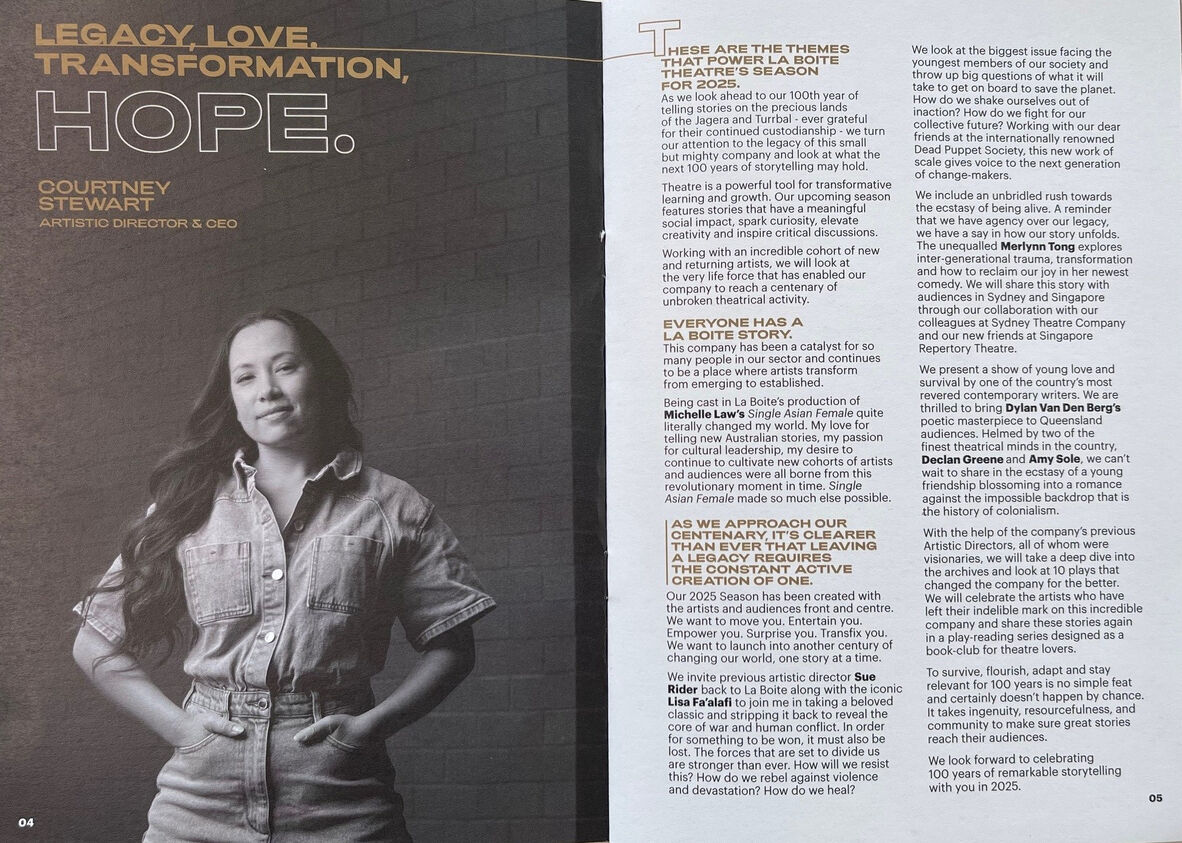
Season program for La Boite Theatre, featuring current Artistic Director & CEO Courtney Stewart, 2025. JEPH: Theatre programs (Brisbane Repertory Theatre Society / La Boite Theatre). John Oxley Library, State Library of Queensland.
Act 8 [the future]
La Boite Theatre Company's current position is strong. It has been included in Creative Australia’s National Performing Arts Partnership Framework and is recognised as Queensland’s 7th major performing arts organisation. Well and truly a fully professional organisation, it still enjoys a nationwide reputation for innovative, even risky programming. As stated in its 2023 Annual Report:
A company that reaches a hundred years embodies a legacy of dedication, innovation and perseverance. It’s a milestone that signifies its ability to evolve with the times, navigate uncertainties and continue thriving amidst adversity. Beyond the numbers, it symbolises a profound impact on society, economy and culture.
It appears certain that the show will go on at La Boite Theatre. This company has remained at once committed to the ideals and extraordinary vision of its founders whilst embracing new opportunities, even at times of great threat, to remain contemporary and relevant. 100 years is an extraordinary achievement for a company that began as an amateur repertory society and grew into a national leader in professional theatre.
La Boite Theatre's story features in Extraordinary stories, on display in the Philip Bacon Heritage Gallery on level 4 at State Library of Queensland from May to November 2025.
Acknowledgements
This article would not have been possible without the excellent work of La Boite historian, Dr Christine Comans.
Read her history of La Boite Theatre in a series of articles on their website or in her publication "La Boite: the story of an Australian theatre company" (2009, Playlab Press).
Thanks also to La Boite Theatre who have been very generous with their time and archive.
Sources
Dr Christine Comans, Brisbane Repertory Theatre Society / La Boite Theatre history blogs, La Boite Theatre: Our history - creating theatre since 1925, accessed 10-21 March 2025
Wikipedia article, La Boite Theatre Company, accessed 10 March 2025
Wikipedia article, Theatre in the round, accessed 17 March 2025
Arts Hub article (published 23 December 2020), Exit Interview: Todd MacDonald, La Boite Theatre Company, accessed 21 March 2025
ABC News article (published 1 March 2023), Courtney Stewart leads La Boite Theatre in Brisbane with a focus on new Australian work by people from diverse communities, accessed 21 March 2025
La Boite Theatre Company Annual Report 2023, accessed 21 March 2025
Comments
Your email address will not be published.
We welcome relevant, respectful comments.